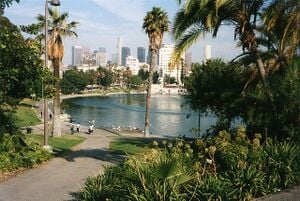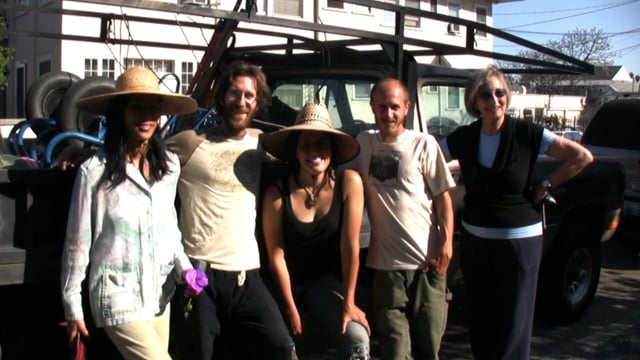
The aim of this page is to recognise, celebrate and encourage the self-empowerment of community agency networks (CANs) and community groups' activism for climate, environment and many other sustainability topics across Los Angeles.
 Millions of Californians live near oil and gas wells that are in the path of wildfires, latimes.com (Jul 21, 2024)
Millions of Californians live near oil and gas wells that are in the path of wildfires, latimes.com (Jul 21, 2024)  This LA Restaurant Serves Up Empowerment for Refugees, reasonstobecheerful.world (Jul 12, 2024)
This LA Restaurant Serves Up Empowerment for Refugees, reasonstobecheerful.world (Jul 12, 2024)  E-bike package delivery is coming to L.A., Fast Company (Jan 28, 2022)
E-bike package delivery is coming to L.A., Fast Company (Jan 28, 2022)
Networks and sustainability initiatives[edit | edit source]
- Transition Los Angeles
- Transition Pasadena is a community action group working to connect, inspire, and support individuals and neighborhoods using the Transition Model to build resilient communities. Our members live in Pasadena, Altadena, and nearby neighborhoods including Highland Park and Eagle Rock. Founded in 2010, our award-winning projects include Throop Learning Garden and Repair Café Pasadena. We also host talks, potluck gatherings, reskilling workshops, and film screenings.
- Los Angeles Eco-Village
Environment quality[edit | edit source]
#DroughtHack, Office of Los Angeles Mayor Eric Garcetti
Wikipedia:
- Los Angeles, Environmental issues: Owing to geography, heavy reliance on automobiles, and the Los Angeles/Long Beach port complex, Los Angeles suffers from air pollution in the form of smog. The Los Angeles Basin and the San Fernando Valley are susceptible to atmospheric inversion, which holds in the exhausts from road vehicles, airplanes, locomotives, shipping, manufacturing, and other sources.
- The smog season lasts from May to October. Unlike other large cities that rely on rain to clear smog, Los Angeles gets only 15 inches (380 mm) of rain each year: pollution accumulates over many consecutive days. Issues of air quality in Los Angeles and other major cities led to the passage of early national environmental legislation, including the Clean Air Act. More recently, the state of California has led the nation in working to limit pollution by mandating low-emission vehicles. Smog is expected to continue to drop in the coming years due to aggressive steps to reduce it, which include electric and hybrid cars, improvements in mass transit, and other measures.
- The number of Stage 1 smog alerts in Los Angeles has declined from over 100 per year in the 1970s to almost zero in the new millennium. Despite improvement, the 2006 and 2007 annual reports of the American Lung Association ranked the city as the most polluted in the country with short-term particle pollution and year-round particle pollution. In 2008, the city was ranked the second most polluted and again had the highest year-round particulate pollution. The city met its goal of providing 20 percent of the city's power from renewable sources in 2010.
- The American Lung Association's 2013 survey ranks the metro area as having the nation's worst smog, and fourth in both short term and year round pollution amounts.
Trees, woodland and forest[edit | edit source]
Coasts[edit | edit source]
Heal the Bay - Santa Monica Bay Restoration Commission - Surfrider Foundation
Community involvement[edit | edit source]
Communities online[edit | edit source]
Cycling activism[edit | edit source]
Bicycle Kitchen, non-profit bicycle cooperative in the East Hollywood neighborhood of Los Angeles, dedicated to educating the community on bicycle repair and maintenance and promoting a velo-centric way of life in America's most car-dominated city. The Bicycle Kitchen Wiki. The Bicycle Kitchen Blog - CicLAvia
Wikipedia:
- Cycling in Los Angeles accounts for less than one percent (0.6%) of all work commutes. Because of the mild climate, there is little need to carry the variety of clothing that cyclists require in other less temperate climates.
- As of 29 April 2008 there were more than 350 miles (560 km) of bike lanes and paths in the Los Angeles bike path network, such as the Los Angeles River bicycle path, which runs from Burbank to Long Beach, with only a brief hiatus through downtown.
- Bike paths in Los Angeles (category)
- CicLAvia is an event held in Los Angeles where streets are closed to motor vehicles and open for the public to walk, bike, and skate through the open streets. Each CicLavia event is planned by the nonprofit organization CicLAvia in partnership with the City of Los Angeles. The event takes place on a given Sunday and is open for a predetermined set of hours. This started out as a once a year occurrence but later expanded to 3 times a year. In fact, plans to have CicLAvia once a month are in the works. While primarily intended for cyclists, many people can be seen skateboarding, running, or walking down the path. Each street that is closed off is guarded by traffic officers who direct the cars to alternative routes through Los Angeles. On some streets the traffic lights are still in service which means the bikers and pedestrians must abide by the traffic laws. Police are guarding each intersection to allow ultimate safety of the community during this event. CicLAvia brings together densely populated and diverse neighborhoods through a bike route. The event now attracts over 100,000 participants and expands to connect even more neighborhoods.
- To expand on their community activism, CicLAvia supports a "carpool" program called Feeder Walks or Rides for people of farther communities to meet up and go together to the event. There are several different cities around LA that use this program for community members to meet up at a specific location and at a specific time to ride their bikes together or walk together to the event so the biker or pedestrian does not have to go alone. This brings a sense of unity to the surrounding communities which is the purpose of the CicLAvia event.
Food activism[edit | edit source]
- Arroyo Food Cooperative, community-owned market
- L.A. Green Grounds, Growing, working, teaching: changing turf into edible gardens in South Los Angeles
- L.A. Kitchen
- Everytable
- Fallen Fruit
- Wikipedia:Ron Finley is known as a proponent of healthy eating and gardening. He is co-founder of LAGREENGROUNDS.ORG, a company that plants gardens at low-income homes in the Los Angeles area as a part of a recovery system to transform neighborhoods. In early 2013, he gave a TED talk on his progress as a "guerrilla gardener," the dangers of food deserts, and the potential for his program to improve quality of life. He said in the talk, "If kids grow kale, kids eat kale; if they grow tomatoes, they eat tomatoes." The program has had modest success in persuading city officials to cooperate, but remains officially illegal under city code.
- Sustainable Economic Enterprises of Los Angeles
Sharing[edit | edit source]
Maps: google.com/maps
Social inclusion[edit | edit source]
Los Angeles Homeless Resource wiki - Social Justice Learning Institute, Inglewood
Sustainable transport activism[edit | edit source]
Wikipedia:
- LA on foot: 3.4% of Los Angeles residents commute to work by walking and Los Angeles residents walk for exercise at rates similar to those of other major U.S. cities.
- There are a number of commercial areas that have been redeveloped in the past two decades specifically to accommodate pedestrian traffic. Old Town Pasadena was redeveloped in the late 1980s by moving parking off Colorado Boulevard so as to make the street pedestrian-focused. Likewise, the Third Street Promenade in Santa Monica was closed off to vehicular traffic altogether in 1965 and revitalized with improved pedestrian amenities in 1988. Downtown Los Angeles has numerous public escalators and skyways, such as the Bunker Hill steps to facilitate pedestrian traffic in the traffic-laden and hilly terrain.
- Downtown Los Angeles is one of two neighborhoods in Los Angeles ranked as a "walker's paradise" (with walk scores 90 or above) by WalkScore.com. The other is Mid-City West, which encompasses the area of the city immediately south of West Hollywood and east of Beverly Hills.
- Nevertheless, much of Los Angeles remains pedestrian unfriendly. A large percentage of sidewalks in the City of Los Angeles (43% or 4,600 miles (7,400 km) of the 10,600 total miles) are in ill repair stemming from the City Council passing an ordinance in 1973 that relieved property owners of responsibility for repair of sidewalks damaged by roots, while failing to concurrently allocate funds for city repairs of such sidewalks. The city began dedicating funds for sidewalk repairs in 2000, but the backlog created by the twenty-six year repair hiatus is severe.
Towards sustainable economies[edit | edit source]
Arroyo Sustainable Economies Community Organization
Urban sustainability[edit | edit source]
Slideshow: Imagine Your Los Angeles Street Beyond Cars
Los Angeles: A History of the Future, how a metropolitan area could be rebuilt, over decades, toward balance with nature.
News sources: Los Angeles Streetsblog, daily news source connecting people to information about sustainable transportation and livable communities.
Maps[edit | edit source]
Cycling: Bicycle maps, LADOT bicycle services
Food: Fallen Fruit, A Mapping of Food Resources in Los Angeles.
Open spaces: LA Open Acres, database of the open, accessible lands in Los Angeles.
Campaigns[edit | edit source]
Cowatching Oil La on facebook
About Los Angeles[edit | edit source]
Los Angeles, often referred to by its initials L.A., is the most populous city in the U.S. state of California. With an estimated 3,820,914 residents within the city limits as of 2023, It is the second-most populous city in the United States, behind only New York City; it is also the commercial, financial and cultural center of Southern California. Los Angeles has an ethnically and culturally diverse population, and is the principal city of a metropolitan area of 12.8 million people (2023). Greater Los Angeles, which includes the Los Angeles and Riverside–San Bernardino metropolitan areas, is a sprawling metropolis of over 18.3 million residents.
The majority of the city proper lies in a basin in Southern California adjacent to the Pacific Ocean in the west and extending partly through the Santa Monica Mountains and north into the San Fernando Valley, with the city bordering the San Gabriel Valley to its east. It covers about 469 square miles (1,210 km2), and is the county seat of Los Angeles County, which is the most populous county in the United States with an estimated 9.86 million residents as of 2022. It is the third-most visited city in the U.S. with over 2.7 million visitors as of 2023.
Past events
- October 16, 2016, CicLAvia - Heart of LA
External links
- Sustainability information from the City of Los Angeles
- Sustainable City pLAn




